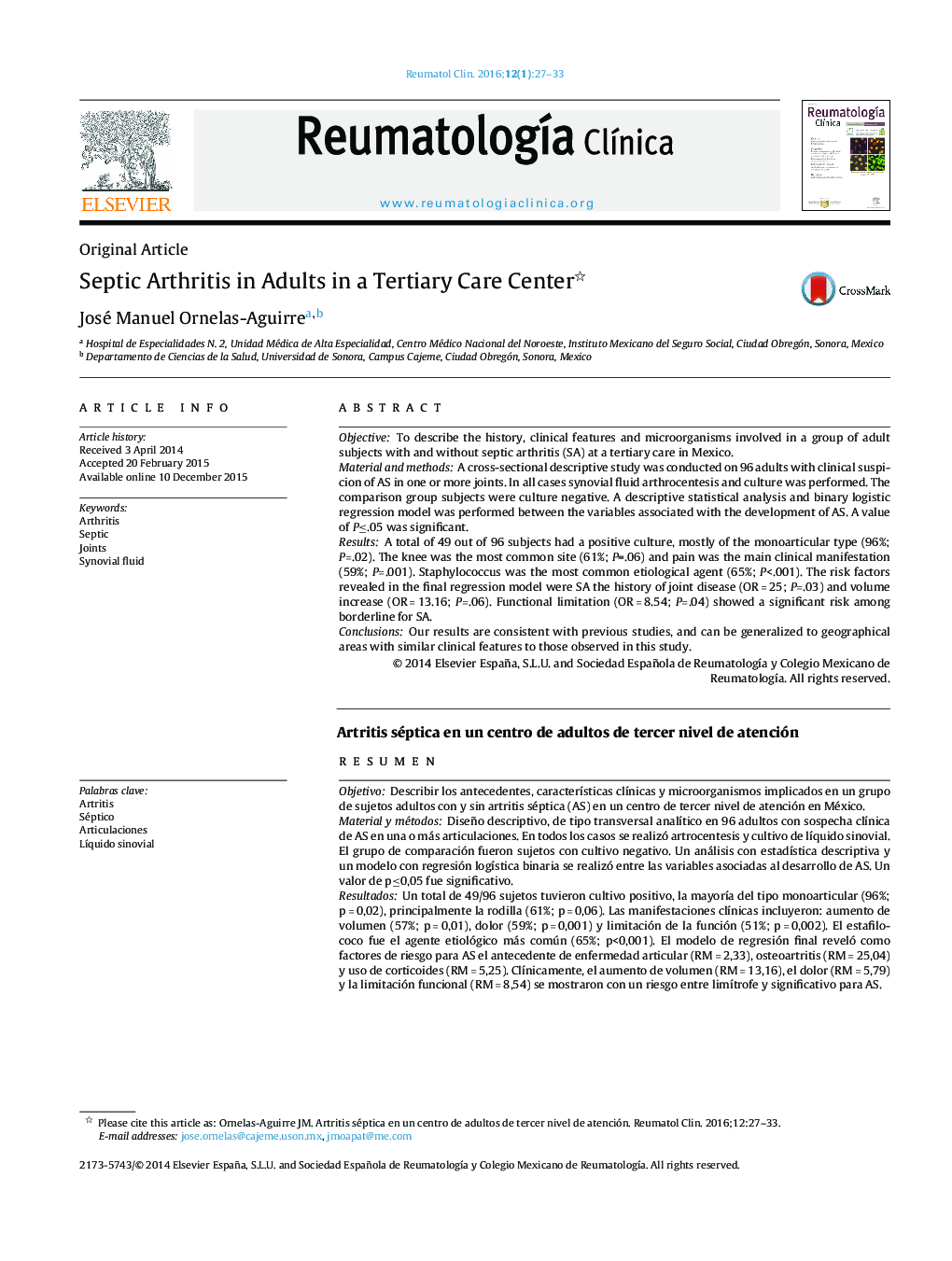| کد مقاله | کد نشریه | سال انتشار | مقاله انگلیسی | نسخه تمام متن |
|---|---|---|---|---|
| 3384121 | 1220512 | 2016 | 7 صفحه PDF | دانلود رایگان |
ObjectiveTo describe the history, clinical features and microorganisms involved in a group of adult subjects with and without septic arthritis (SA) at a tertiary care in Mexico.Material and methodsA cross-sectional descriptive study was conducted on 96 adults with clinical suspicion of AS in one or more joints. In all cases synovial fluid arthrocentesis and culture was performed. The comparison group subjects were culture negative. A descriptive statistical analysis and binary logistic regression model was performed between the variables associated with the development of AS. A value of P≤.05 was significant.ResultsA total of 49 out of 96 subjects had a positive culture, mostly of the monoarticular type (96%; P=.02). The knee was the most common site (61%; P=.06) and pain was the main clinical manifestation (59%; P=.001). Staphylococcus was the most common etiological agent (65%; P<.001). The risk factors revealed in the final regression model were SA the history of joint disease (OR = 25; P=.03) and volume increase (OR = 13.16; P=.06). Functional limitation (OR = 8.54; P=.04) showed a significant risk among borderline for SA.ConclusionsOur results are consistent with previous studies, and can be generalized to geographical areas with similar clinical features to those observed in this study.
ResumenObjetivoDescribir los antecedentes, características clínicas y microorganismos implicados en un grupo de sujetos adultos con y sin artritis séptica (AS) en un centro de tercer nivel de atención en México.Material y métodosDiseño descriptivo, de tipo transversal analítico en 96 adultos con sospecha clínica de AS en una o más articulaciones. En todos los casos se realizó artrocentesis y cultivo de líquido sinovial. El grupo de comparación fueron sujetos con cultivo negativo. Un análisis con estadística descriptiva y un modelo con regresión logística binaria se realizó entre las variables asociadas al desarrollo de AS. Un valor de p≤0,05 fue significativo.ResultadosUn total de 49/96 sujetos tuvieron cultivo positivo, la mayoría del tipo monoarticular (96%; p = 0,02), principalmente la rodilla (61%; p = 0,06). Las manifestaciones clínicas incluyeron: aumento de volumen (57%; p = 0,01), dolor (59%; p = 0,001) y limitación de la función (51%; p = 0,002). El estafilococo fue el agente etiológico más común (65%; p<0,001). El modelo de regresión final reveló como factores de riesgo para AS el antecedente de enfermedad articular (RM = 2,33), osteoartritis (RM = 25,04) y uso de corticoides (RM = 5,25). Clínicamente, el aumento de volumen (RM = 13,16), el dolor (RM = 5,79) y la limitación funcional (RM = 8,54) se mostraron con un riesgo entre limítrofe y significativo para AS.ConclusionesNuestros resultados son congruentes con estudios previos y pueden generalizarse a zonas geográficas con características clínicas similares a las observadas en este estudio.
Journal: Reumatología Clínica (English Edition) - Volume 12, Issue 1, January–February 2016, Pages 27–33
